(i) GDP Data
In 2005, XPCC realized a total output value of 33.112 billion Yuan including an output value of primary industry of 13.064 billion Yuan, that of secondary industry of 8.335 billion Yuan, that of tertiary industry of 11.713 billion Yuan with the proportion of the three industries as 40:25:35, per capita total output value as 12,900 Yuan.
GDP of XPCC in 2005
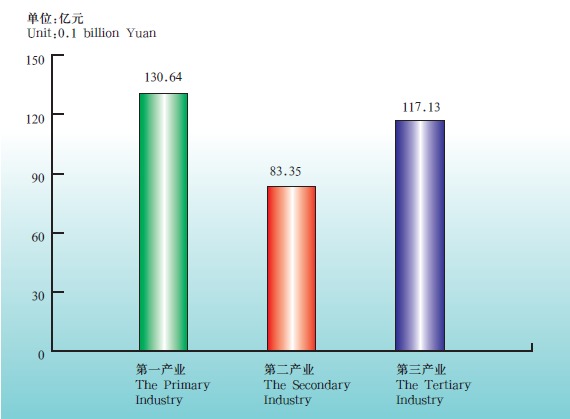
(ii) Natural Resources
Land Resources
XPCC has a total acreage of 7.45627 million hectares, including land for agricultural use of 4.19264 million hectares, land for construction use of 0.20989 million hectares, unused land of 3.05374 million hectares. Land for agricultural use includes: farmland of 0.10465 million hectares, garden plot of 0.06358 million hectares, woodland of 0.14216 million hectares, pastures of 2.4269 million hectares, other land for agricultural use of 0.21935 million hectares.

Mineral Resources

Xinjiang has minerals of complete types and large reserves, broad development prospect. Out of the 171 known kinds of minerals in China, Xinjiang has discovered 138 kinds with verified resource reserves of 117 kinds, including 5 kinds of reserves ranking first in China, 24 kinds in the first five places in China, 43 kinds in the first ten places in China, 23 kinds ranking first in the northwest. Xinjiang has rich reserves of petroleum, natural gas, coal, gold, chromium, copper, nickel, rare metals, salt minerals, bentonite, building materials and nonmetallic materials. According to forecast, Xinjiang has forecast coal stock size of 2.19 trillion billion tons, covering
40% of the total amount in China, ranking first; that of oil 20.86 billion tons, covering 30% of the total land oil stock size in China, that of natural gas 10.3 trillion cubic meters, covering 34% of the total land natural gas stock size, and other famous resources since ancient times such as gold, gem and jade.

Water Resources
Xinjiang has annual surface water resources (utilization of surface water) of 8.9 billion cubic meters, exploitable ground water resources of 5.2 billion cubic meters, an effective irrigated area of 1 million hectares, and water-saving area of 53.9 hectares. By the end of 2005, XPCC had 114 reservoirs with a total storage capacity of 3.163 billion cubic meters, including 11 large-scale reservoirs with a storage capacity of 1.876 billion cubic meters, 27 medium-sized reservoirs with a storage capacity of 1.109 billion cubic meters, 76 small reservoirs with a storage capacity of 216 million cubic meters, irrigation canals with a total length of 99,400 kilometers including 26,700 kilometers under penetration protection, drainage channel with a total length of 42,600 kilometers, 102,400 channel buildings of various kinds, 10,600 electromechanical pump wells including 10,200 with support facilities and with a water furnishing ability of 299.03 cubic meters per second, a water lifting quantity of 1.45 billion cubic meters, 115 locations of 10,000-mu irrigation areas including 7 locations of 500,000-mu irrigation areas, 11 locations of 20,000-30,000-hectare irrigation areas. It has embankment with a total length of 2,107 kilometers, a population of 1.44 million under protection, farmland with an area of 0.3678 million hectares under protection. It constructed 90 sluices on the river including 3 large-scale sluices, 26 medium-sized sluices and 61 small sluices. XPCC has a total irrigated area of 1.17112 million hectares, water conservancy projects with an annual water supply of 13.06 billion cubic meters, including 11.755 billion cubic meters for agricultural water supply, 70 million cubic meters for industrial water supply, 148 million cubic meters for urban and rural domestic water and 87 million cubic meters for ecologic use.

Biological Resources
Situated at the communications center of Eurasia with combination of East and West animal and plant varieties, and diverse and unique physical geographic conditions, Xinjiang is extremely rich in biological resources.
Xinjiang has complete temperate zone crops, with wheat, corn, paddy rice as main crops. In most areas it is suitable to plant miscellaneous grains such as sorghum, barley, soybean, pea, mung bean, broad bean, millet, millet and sweet potato. The Ili River valley is always known as "Xinjiang granary".

"Tianshan snow" rice is as clean as pearl bead, with fine texture and fragrant taste. Economic crops include cotton, beet, rape, sunflower, hops, aspic, flax, tobacco and medicinal materials. XPCC' upland cotton, long-staple cotton and color cotton kapok, beet, oil-bearing crops, hops and ketchup ranking first in both output and quality in China's agricultural cultivation, cotton yield of per unit area and per capita occupancy ranking first in China.
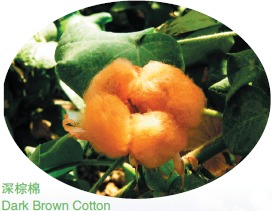
Xinjiang is known as "home-town of fruits and melons". The common fruits and melons include: melon (Hami melon), watermelon, apple, bergamot pear, grape, apricot, peach, plum, red jujube, pomegranate, cherry, fig, walnut and almond, vegetable crops are quite rich, including cabbage, spinach, coriander, wild cabbage, yellow radish, green radish, potato, spring onions, kidney bean, tomato, onion, red pepper, eggplant, celery, Chinese chive, cucumber, bottle gourd, balsam pear, pumpkin, sponge gourd, wax gourd. Various temperate zone fruits, vegetables and melons can be seen everywhere.



Xinjiang is one of the five big pastoral areas with many animals with sheep ranking first in quantity, followed by horse, cattle, goat, donkey, camel, mule, pig and deer, fowls including chicken, duck and goose, Ili horse, Yiwu horse, Yanqi horse, Balikun horse, Shihezi land reclamation fine-wool sheep, Altay fatrumped sheep, Xinjiang brown cattle, Kuqa black budge sheep, and ili dairy and beef cattle quite famous. XPCC meat output ranks fi rst in output in China's agricultural cultivation.

Xinjiang has 90 kinds of fish, including quite precious Buluntuo Lake and Erqis River sturgeon, salmon, River perch, Silver prussian carp, Siberian roach, Pikeperch, Gold Crucian Carp, Leuciscus idus, Burbot, European bream, and loving Buluntuo Lake and Erqis River River perch, Culter, Bositeng Lake pipefish, Barbless carp, Ili River Carp and Perch.
In terms of wild plants, there are edible, medicinal, technical, sandfixation and appreciation plants of 132 species, 856 families, nearly 4,000 kinds, including over 1,000 kinds of economic and medicinal plants, over 100 kinds of rare plants, such as liquorice, Fritillary Bulb, Safflower, Snow Lotus, Desertliving Cistanche, Dwarf Lilyturf Tuber, Chinese Angelica, Tangshen Root, Chinese Asafoetida, Desertliving Cistanche, gentian, Ephedra Herb, Barbary Wolfberry Fruit and medlar. Xinjiang Uygur Autonomous Region has its licorice ranking first in terms of both area and yield in China, XPCC has a licorice area of 26,700 hectares.

Furthermore, Xinjiang has diversiform-leaved poplar, narrow-leaved oleaster, wild apple, wild walnut, wild apricot, wild almond tree, wild Chinese hawthorn, shiny-leaved yellow-horn, wild rose, bluish dogbane, rubber grass, reed, splendid achnatherum and sacsaoul grass. Xinjiang's diversiform-leaved poplar area covers 95% that in China. XPCC administers a diversiform -leaved poplar area of 40,000 hectares.

Xinjiang has 580 kinds of wild animals including over 340 kinds of birds, over 130 kinds of mammals with over 80 kinds listed as rare animals under national protection. 20 kinds are of first category animals under national protection, mainly including wild horse, wild yak, wild camel, Tibetan wild ass, Mongolian wild ass, Xinjiang tiger, snow leopard, Tibetan antelope, saiga, beaver, wolverine, white stork, black stork, white crane, black-necked crane, white-shouldered vulture, spot-billed pelican, Tibetan snow cock, peregrine falcon and Horned Grebe.
Xinjiang has 67 kinds of animals under national second category protection, mainly including brown bear, sable, lynx, red deer, ibex, swan, jade belt sea vulture. In addition, there are many common wild animals such as Bositeng Lake and Tarim riverside muskrat, oasis and desert hare, Tianshan and Altay pasture marmot, Mongolian gazelle, wolf, fox, Huocheng Horsfield's tortoise including red deer, muskrat, snow cock and mink, which are successfully tamed and reproduced in XPCC reclamation area and becoming important materials to earn foreign exchange through export.
(iii) Animal Husbandry Development
XPCC has agriculture as its economic foundation and superiority, and agricultural modernization take lead in China. With farmland of 1.05 million hectares, sown area of 0.98 million hectares, gardening production area of 140,000 hectares. XPCC is China's most important high quality cotton production center and biggest water-saving agricultural irrigation area, with a cotton output of 0.987 million tons, covering one sixth of China's total cotton, export covering a half of China's total cotton export. XPCC has its Jin Brand, Yinli Brand and Beijiang Brand cotton rank the first three places among China's top ten brands, Xinnong Brand among the top ten best sellers at China's cotton market. XPCC has had its cotton, grape, tomato, bergamot pear, red deer, dairy products and feed form specialized production, processing and industrialized production management, processing tomato productivity reach 600,000 tons ranking second in the same trade in the world and the products sell well in more than 40 countries and regions. Grape wine productivity reached 120,000 tons, with alcohol brewing grape planting area of 150,000 mu ranking first in China and Asia. Its 6 pillar industries, namely, cotton industry, grain, oil and sugar processing industry, fruits and vegetables processing industry, livestock products, alcohol industry and seed industry rapidly developed.

In 2005, XPCC had a total agricultural output value of 27.352 billion Yuan, and continued to adjust crop planting structure. It had a sown area of 985,800 hectares, including grain sown area of 228,000 hectares, cotton sown area of 471,700 hectares, oil sown area of 46,500 hectares, beet sown area of 20,500 hectares. The output of main agricultural products such as grain, cotton, beet and fruits greatly increased, with cotton output creating a historical new record.
Main Agricultural Products Output
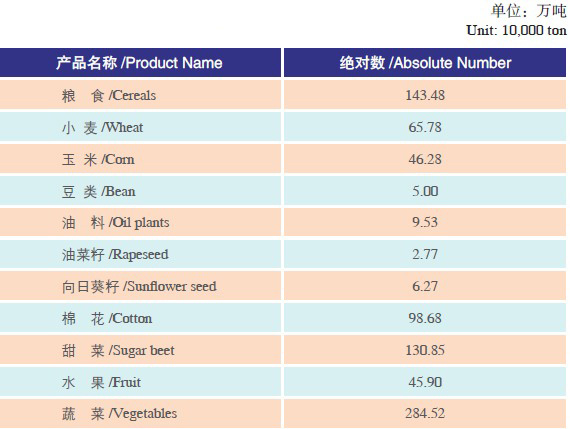
Artificial afforestation area of 21,800 hectares completed, including 9,700 hectares returning land for farming to forestry.
Amount of livestock on hand at the end of the year: 7.8318 million, main livestock products such as meat, wool and milk with a comprehensive output increase.
Aquatic products output in 2005: 20,000 tons.
Total power of agriculture machinery in 2005: 2.493 million KW.
Husbandry Production

Agricultural Mechanization

Animal Husbandry Center
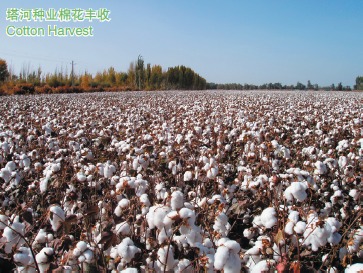
High quality commodity cotton production center XPCC's various reclamation areas useable for cotton production have a typical temperate zone continental climate, long sunshine time, rich light resources, dry nature and few rainfall , centralized precipitation, which benefits growth of thermophilic crops such as cotton. For half a century, developing cotton through science and technology, XPCC has successively created a breakthrough of cotton planting forbidden area of latitude 44 N, and made miracles of large area high production of cotton in the Manas River basin; developed over 30 improved seeds such as Junmian 1, long-staple cotton Junhai 1, Xinluzao 1, summarized "short, dense, drought and membrane" comprehensive and complete high yield technology, introduced and successfully promoted miracles of mechanical cotton picking technology, had cotton output covering one sixth of China's total cotton, export covering a half of China's total cotton export, with first class cotton rate of above 85%. XPCC is China's most important high quality commodity cotton production center.

Important grain and oil production center
XPCC adopts advanced precision agriculture planting technology, vigorously develops high quality special-purpose wheat, high quality paddy rice and oil-bearing crops and enhances market competitive force. It has its products such as "Tianshan Snow", "Yihe Double Six" rice, "Dali", "Saimolin", "Chengmian", "Qiaoerma"Teyi flour, "Lingyangmai", "Jintun" and cooking oil obtaining green food authentication.
Important livestock product center
XPCC has rapidly developed its animal husbandry and made it an important part of agricultural economy, constructed high quality livestock product center with high quality dairy cattle center, beef cattle center, mutton sheep center, fine-wool sheep center and red deer center as main and cultivated international leading fine-wool sheep new variety-China's Merino sheep.

Licorice production center
With a total area of more than 300,000 mu, including more than 60,000 mu for man-power planting, this center has formed industrialized production with licorice slice and licorice extract as main products.
Breeding of better stocks and characteristic fruits and melons
Breeding of better stocks XPCC has vigorously selected breeds, introduced crop varieties including more than 700 from abroad, and more than 120 self-cultivated varieties. XPCC has constructed 2 state-level better stock breeding centers, 11 high quality better stock cotton breeding centers with a seed-selecting working rate of 95% or more. Improved seed selective breeding has greatly promoted XPCC agricultural economic development.
The 3 enterprises of XPCC, namely, Xinjiang Kangdi Agricultural Science& Technology Development CO. Ltd., Tianhe Seeding Co. Ltd. and Jinbo Seeding Center, have become among China's top 50 seeding enterprises.
Characteristic fruits and melons

Xinjiang is always praised as hometown of fruits and melons. XPCC' has its centers of high quality characteristic fruits and melons spread north and south Tianshan. XPCC Agricultural No.2 Division has had its "Elliman" brand Korla bergamot pear win Gold Medal of the Second Agricultural Exposition, Famous Brand Product of China International Agriculture Exposition, China Green Food Kunming Exposition Best-selling Product Award, and obtain China Green Product Reasoning; No.143 Regiment of Agricultural No.8 Division has been appointed as "hometown of flat Peaches" by organizational committee of recommendation and publicity activities of China Special Product Economic Commission and China Special Product Hometown, No.83 Regiment of Agricultural No.5 Division has been appointed by Economic Forestry Society of State Forestry Administration as "hometown of Medlar", Agricultural No.13 Division has been appointed by Economic Forestry Society of State Forestry Administration as "hometown of China's famous, excellent and special economic forests".
Agricultural Industrialization
XPCC has 29 leading agricultural industrialized enterprises including 8 state-level enterprises.

Fast-rising red industry. Chalkis Tomato Product Co., Ltd. is a state-level leading agriculture industrialized enterprise with a tomato sown area of 36,300 hectares and an annual output of 2.69 million tons. XPCC has tomato products of more than 30 varieties and an annual ketchup and its product productivity of 600,000 tons, export covering 50% of China's total export amount, has formed an industrial chain with vat ketchup as initial product, tomato cubes, peeled entire tomato, small package tomato products as middle product, lycopene and other products with high added value as terminal. XPCC has had its products passed 7 authentications, namely, ISO9002, ISO14001 and HACCP, Judaism, European Food Organization, non-transgene variety authentication and Islamic food authentication. The products sell well in more than 70 countries and regions.

Vigorously developing brewing industry. Xinjiang is one of the high quality grape production areas in the world. Relying on the superior climatic characteristics of rich heat resources, long sunshine time, big diurnal amplitude and small precipitation north and south of Tianshan Mountains, XPCC vigorously develops grape planting and brewing center.
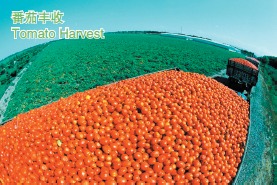
Sun-time International Wine Co., Ltd. is a state-level leading agriculture industrialized enterprise, the largest monomer wine plant in Asia, with 6 wine plants and an annual high quality grape wine productivity of 120,000 tons, a daily filling ability of 200 tons, with its products selling well at domestic and international markets, constructed a 150,000-mu high quality winemaking grape center, the largest in Asia. Suntime series grape wine has obtained green food certificate and qualification of National Products Exempt from Inspection from National Green Food Development Center, in 2005 obtained China famous brand product certificate from General Administration of Quality Supervision, Inspection and Quarantine, won multiple gold and silver medals at the second, fourth and sixth international grape wine and liquor appraisal meeting and at Asian grape wine quality contest respectively.

Xinjiang Yilite Industry Co. Ltd. is a state-level leading agriculture industrialized enterprise, mainly producing Yili Tequ Liquor, Yili Lao Jiao Liquor, Yili Brand Liquor and other products of more than 100 varieties, in 9 series. The products sell well in many foreign countries such as Australia, Commonwealth of Independent States, Japan and Republic of Korea. "Yili" trademark has been evaluated by Administration for Industry & Commerce of People's Republic of China as "China famous trademark" and the company has become among China's top ten liquor enterprises.
China's largest "Tiancai" color cotton production center; In 2005, it had an ordering purchase area of 70,000 mu. Forming agricultural industrialized scale, "rainbow" color cotton holds an important share at the international and domestic raw material market, and product varieties are complete.
XPCC has the center for production, processing, scientific research, international trade and breeding of hops, melons and vegetables of improved varieties, which has become the largest fragrant hops export center in China. The center enterprise has established hops planting, melon and vegetable breeding centers in 12 farming and animal husbandry regiments, 21 organs in south and north Xinjiang through methods such as order entrust production, land tenancy production and buying shares with land, with a hops planting area of 20,000 mu and an annual average hops processing capacity of 3,000 tons. Hops sell to Japan, Germany and other countries, melon and vegetable improved varieties sell to US, Holland, Japan, Republic of Korea, Chile and other countries.
XPCC dairy industry has formed an industrial structure of farmer plus center plus market, Yinqiao International (Kuytun, Xinjiang) Dairy Co., Ltd. has its first period construction scale as 300 t/d fresh milk processing, mainly produces full cream evaporated milk powder, full cream sweetened milk powder and formula milk powder.
(iv) Industrial Development
Having its industry take agricultural and subsidiary product processing as main body, energy and basic industry as matching, XPCC has constructed a resource-based industry structure system with textile, food, papermaking, leather, steel, electric power, coal, building materials, chemicals, machine-building and electronics as backbone, adapting to practical situation of Xinjiang and XPCC. In 2005, XPCC had an industrial added value of 5.65 billion Yuan, a gross value of industrial output of 17.564 billion Yuan including light industrial output value of 9.293 billion Yuan, heavy industry output value of 8.271 billion Yuan, realized an industrial sales output value of 16.89 billion Yuan, industrial product sales rate of 96.2%.
Gross industrial output value by categories of XPCC

Output of main industrial products
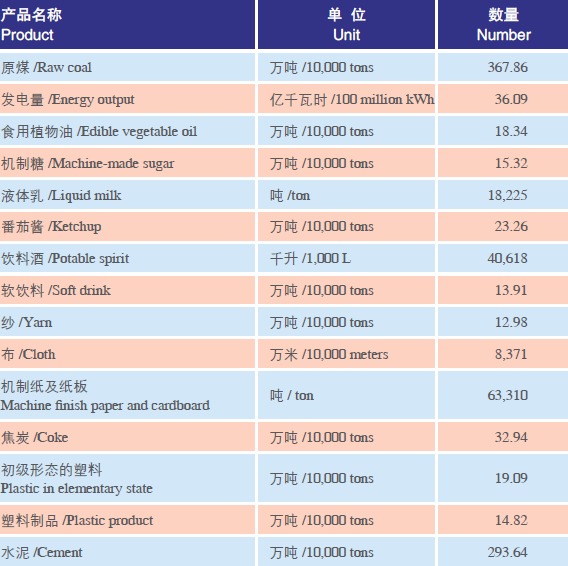
Chemical industry
XPCC enterprises fully used their rich mineral resources in Xinjiang such as coal, salt and limestone according to circular economic type constructed a new type industrial garden with an annual production of 360,000 tons of polyvinyl chlorides, 280,000 tons of caustic soda, 200,000-kilowatt matching self-supply power plant, 300,000 tons of calcium carbide, 300,000 tons of cement, and formed an interior organic circulation within the group from mineral resources to chemical products, from chemical products to water-saving equipment, from water-saving equipment to highly effective ecological agriculture.

XPCC has had its agricultural water-saving equipment production reach an annual capacity of 6 million mu, with its technical level, scale of production and market taking lead in the world.
Textile industry
XPCC has 0.95 million cotton textile spindles (ring spindle) with its products exported to various places in the world.
Electric power industry
In 2005, XPCC had an electric-power output of 3.609 billion kWh. Its Xinjiang Tianfu Thermoelectric Co., Ltd. is the first listed company of combined thermal power generation in the Northwest, with a total installed capacity of 263.55 megawatts, an annual electric-power output of 1.7 billion kWh, electricity supply capacity of 1.7 billion kWh, heat supply capacity of 10 million GJ, 31 110-kilovolt and 35-kilovolt transformer substations, 480-kilometer 110 kilovolt transmission lines, 440-kilometer 35 kilovolt transmission lines, a power supply radius of 150 kilometers, a heating radius of 8 kilometers, a heating area of 7 million square meters.

Architectural industry
In 2005, XPCC had an added value of architectural industry of 2.685 billion Yuan, a total output value of construction enterprise architecture industry of 9.858 billion yuan, a staff technical equipment rate of 5,928 yuan/person, a labor productivity of 89,748 yuan/person, a power equipment rate of 3.99 kilowatts/person.

XPCC possesses a 400,000 t/a coke center.
(v) Commercial Development
Foreign trade According to the customs, in 2005, XPCC had a total import and export amount of 3.105 billion US dollars with the increase ranking first in China. XPCC has already conducted trade with 135 countries and regions with over 3,000 varieties of import-export goods. XPCC has now 690 various enterprises with foreign trade rights. Various divisions and private enterprises rapidly increase their import and export trade, which is a bright attraction in the development of foreign trade. Foreign trade is growing in a proper way. XPCC has now 10 enterprises with an annual import and export amount of 100 million US dollars, 40 with an annual import and export amount of 10 million US dollars. Foreign trade enterprise sales income and total profit maintain a growth of two digits. 6 enterprises have successively become among China's top 500 import-export enterprises.
Total Import and Export Amount by Trade Methods in 2005

Foreign capital introduction
In 2006, XPCC approved 17 foreign capital projects, had a contract foreign capital amount of 55.46 million US dollars, actually used a foreign capital of 43 million US dollars, three types of foreign-funded enterprises had an import and export amount over 13 million US dollars. The investment involved in textile, food, light industry and agriculture.
Foreign economic and technical cooperation
In 2005, XPCC had its foreign contract projects complete a turnover of 29.19 million US dollars, and sent out 603 service personnel under foreign contracting projects, month-end number of service personnel abroad as 426. XPCC has had a foreign investment accumulative authorized amount of 15.30 million US dollars. XPCC has had its enterprises gain success in Cuba and Mexico in investment construction for agricultural comprehensive development project, making project countries' demonstration project. XPCC has had its enterprises gain outstanding achievements in Algeria, Kyrgyzstan, Pakistan, Mongolia and The United Arab Emirates in housing, roads, hydroelectric power stations and post-disaster reconstruction. XPCC has its enterprises seek for agricultural comprehensive development in Volgograd State, Russia.

Circulation of commodities
Domestic trade in 2005, XPCC had social consumable total volume of retail sales of 9.338 billion Yuan, wholesale and retail sales trade retail turnover of 7.303 billion Yuan, food and beverage retail turnover of 1.242 billion Yuan, annual entire social commodity purchase total amount of 35.824 billion Yuan, commodity total sales of 36.931 billion Yuan including above quota wholesale and retail trade commodity purchase total amount of 28.258 billion Yuan, commodity total sales of 28.82 billion Yuan. The consumption structure unceasingly improves, expenditure diverse tendency is obvious.
Construction of commodity market system
XPCC has formed commodity trade and exchange market system with comprehensive market as main, specialized market as auxiliary. XPCC has now 232 commodity markets of various kinds, including 190 comprehensive free markets of agricultural products, 28 industrial consumable markets, 7 vegetable and agricultural and subsidiary product wholesale markets, 7 markets of other kinds, 11 commodity trade markets each with an annual wholesale amount of over 100 million yuan. Department stores, supermarkets, large-scale comprehensive supermarkets, shopping centers and stores in a storehouse, specialized shops and groceries, and other commercial facilities develop in good order.

Related Articles:
Doing Business in XPCC of China: Survey
Doing Business in XPCC of China: Investment
Doing Business in XPCC of China: Development Zones





